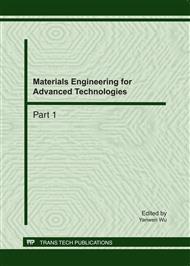p.250
p.256
p.261
p.266
p.272
p.278
p.283
p.288
p.294
High-Grade Utilization of Recovering Wastewater from Cinnamomum Camphora Oil
Abstract:
The production of noble Cinnamomum camphora oil from C. camphora leaves and twigs brings a mass of extracting wastewater which is pollutive to water environment. In order to better utilize and recover the productive wastewater from the Eucalyptus oil, we used GC/MS to analyze the possible top value-added components of benzene/ethanol extractives of leaves and twigs of C.camphora. The analytical result showed that only 15 compounds were identified from the benzene/ethanol extractive of C. camphora trigs, and 29 compounds from 30 peaks were identified from the benzene/ethanol extractive of C. camphora leaves. The analytical result showed that the main components of the benzene/ethanol extractive of C. camphora twigs by GC/MS are as: Bicyclo[2.2.1]heptan-2-one, 1,7,7-trimethyl-, (1R)- (36.85%), Linalyl propanoate (23.58%), Eucalyptol (10.07%), 1,3-Benzodioxole, 5-(2-propenyl)- (8.88%), 4,4-dimethylcholest-7-ene-3-ol (5.81%), Cyclopentanol (3.37%), 1,2,4-Cyclopentanetrione, 3-(2-pentenyl)- (2.52%), etc. The result by GC/MS analysis showed that the benzene/ethanol extractive of leaves of C. camphora are as: Eucalyptol (58.51%), 3-Cyclohexene-1-methanol, .alpha.,.alpha.4-trimethyl- (13.98% from two peaks), Sabinene (4.45%), 1-Mercapto-2-heptadecanone (2.69%), Phytol (2.29%), Camphene (1.94%), 1-Eicosanol (1.81%), Caryophyllene (1.63%), 1,3-Benzodioxole, 5,5'-(tetrahydro- 1H,3H-furo[3,4-c]furan-1,4-diyl)bis-, [1S-(1.alpha.,3a.alpha.,4.beta.,6a.alpha.)]- (1.50%), 1-Penten- 3-ol (1.01%), beta.-Pinene (0.86%), etc. There are many important constituents of rare natural medicine, cosmetic and spicery in the benzene/ethanol extractive of twigs and leaves of C. camphora.
Info:
Periodical:
Pages:
272-277
Citation:
Online since:
June 2011
Authors:
Price:
Сopyright:
© 2011 Trans Tech Publications Ltd. All Rights Reserved
Share:
Citation:


